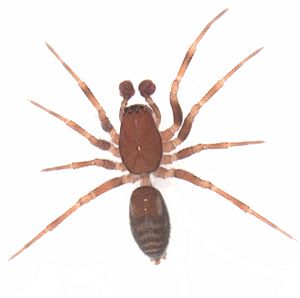Dunedinia facts for kids
Quick facts for kids Dunedinia |
|
|---|---|
 |
|
| Scientific classification |
|
| Kingdom: | Animalia |
| Phylum: | Arthropoda |
| Subphylum: | Chelicerata |
| Class: | Arachnida |
| Order: | Araneae |
| Infraorder: | Araneomorphae |
| Family: | Linyphiidae |
| Genus: | Dunedinia Millidge, 1988 |
| Type species | |
| D. denticulata Millidge, 1988
|
|
| Species | |
|
5, see text |
|
Dunedinia is a small group of tiny spiders. They are known as dwarf spiders. These spiders live in the South Pacific region, mainly in New Zealand and parts of Australia.
This group of spiders is called a genus. It was first described by a scientist named Alfred Frank Millidge in 1988. When a scientist "describes" a new genus or species, it means they officially name it and write down all its features.
What are Dwarf Spiders?
Dwarf spiders are part of a large spider family called Linyphiidae. They are usually very small, often less than 5 millimeters long. This makes them hard to spot!
Many dwarf spiders build sheet-like webs. These webs are often found close to the ground or in low plants. They use these webs to catch tiny insects for food.
Species of Dunedinia
As of May 2019, there are five known species in the Dunedinia genus. Each species has its own unique features and lives in specific places.
Here are the five species:
- Dunedinia decolor Millidge, 1988 – This species is found in New Zealand.
- Dunedinia denticulata Millidge, 1988 (type) – This is the "type species" for the genus. It means it's the main example that helps define the Dunedinia group. It also lives in New Zealand.
- Dunedinia occidentalis Millidge, 1993 – This species is found in Western Australia.
- Dunedinia opaca Millidge, 1993 – You can find this species in South Australia.
- Dunedinia pullata Millidge, 1988 – This species is another one that lives in New Zealand.
Where Do They Live?
The Dunedinia spiders are found in the South Pacific. Three of the five species live in New Zealand. The other two species are found in different parts of Australia. This shows that these tiny spiders have spread across different islands and landmasses in the region.
Scientists continue to study spiders like Dunedinia. They want to learn more about where they live and how they fit into their ecosystems.
See also
 In Spanish: Dunedinia para niños
In Spanish: Dunedinia para niños

